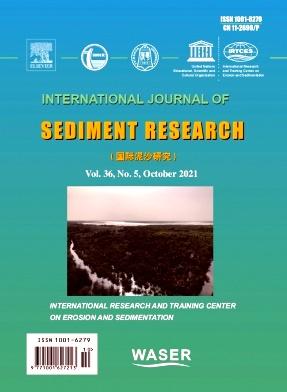在考虑水温影响的情况下,对沙槽中移动平板的水力粗糙度进行了模拟
IF 3.5
2区 环境科学与生态学
Q2 ENVIRONMENTAL SCIENCES
引用次数: 0
摘要
在河道整治工程中,移动平板机的流阻预测(通常用水力粗糙度来量化)是影响水位计算精度的关键问题。在可移动的平板上的床载运动造成额外的能量损失并增加水力粗糙度。已经提出了几种描述这一现象的理论和经验预测因子,但这些模型的准确性和物理基础有待提高。在本研究中,将总耗散率分为两部分:颗粒阻力耗散率和层质运动附加耗散率。在能量耗散率平衡方程的基础上,提出了一种新的可动平板流的预测模型。水温与流体粘度及其相关的物理变量进行了经验耦合。建立了两个无量纲流沙组合变量之间的经验关系,用以划分水温引起的各种河床转变。将新预测器与其他预测器进行比较,并将预测结果与实测数据进行比较。误差度量显示,新的预测器提供了最高的准确度,826个数据点中的~ 88.5%落在±30%的误差范围内。新的预测结果表明,附加阻力与颗粒阻力呈非线性正比关系,并且这两个参数之间的比例因子与5个流沙变量有关。此外,还检验了新预测器量化水温效应的能力。随着水温的升高,预测阻力呈现出三种变化模式,与实测结果吻合较好。水温对活动平板阻力的影响由悬浮数和粗糙度雷诺数共同控制。该研究提供了一个有效的预测器,可用于决策者对可移动平板的水力粗糙度进行建模。本文章由计算机程序翻译,如有差异,请以英文原文为准。
Modeling the hydraulic roughness of a movable flatbed in a sand channel while considering the effects of water temperature
The prediction of the flow resistance (usually quantified as the hydraulic roughness) of a movable flatbed is a key issue affecting the calculation accuracy of flood levels in river training projects. Bedload motion on a movable flatbed causes additional energy loss and increases hydraulic roughness. Several theoretical and empirical predictors for characterizing this phenomenon have been proposed, but the accuracy and physical basis of these models should be improved. In this study, the total energy dissipation rate is separated into two components: the energy dissipation rate due to grain drag and the additional energy dissipation rate due to bedload motion. Following the energy dissipation rate balance equation, a new predictor was proposed for movable flatbed flows. The water temperature was empirically coupled with the fluid viscosity and its associated physical variables. A new empirical relation between two dimensionless flow‒sediment combination variables was established to demarcate the various bedform transitions induced by the water temperature. The new predictor was compared with other predictors, and the prediction results were compared to the measured data. The error metric showed that the new predictor provided the highest accuracy, with ∼88.5% of the 826 data points falling within the ±30% error band. The new predictor suggested that the additional drag is nonlinearly proportional to the grain drag, and the scale factor between these two parameters is related to five flow‒sediment variables. In addition, the ability of the new predictor to quantify water temperature effects was examined. The predicted resistance exhibited three change modes with increasing water temperature, and the results suitably agreed with the measurements. The effect of the water temperature on the resistance of a movable flatbed is jointly controlled by the suspension number and roughness Reynolds number. This study provides an effective predictor that can be used by decision makers for modeling the hydraulic roughness of a movable flatbed.
求助全文
通过发布文献求助,成功后即可免费获取论文全文。
去求助
来源期刊
CiteScore
6.90
自引率
5.60%
发文量
88
审稿时长
74 days
期刊介绍:
International Journal of Sediment Research, the Official Journal of The International Research and Training Center on Erosion and Sedimentation and The World Association for Sedimentation and Erosion Research, publishes scientific and technical papers on all aspects of erosion and sedimentation interpreted in its widest sense.
The subject matter is to include not only the mechanics of sediment transport and fluvial processes, but also what is related to geography, geomorphology, soil erosion, watershed management, sedimentology, environmental and ecological impacts of sedimentation, social and economical effects of sedimentation and its assessment, etc. Special attention is paid to engineering problems related to sedimentation and erosion.

 求助内容:
求助内容: 应助结果提醒方式:
应助结果提醒方式:


